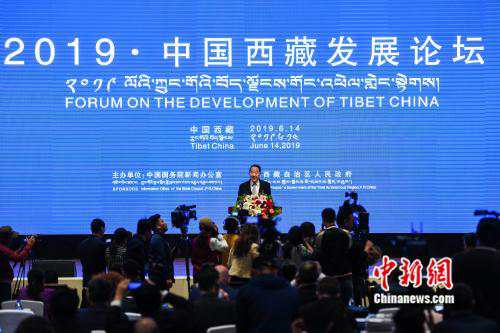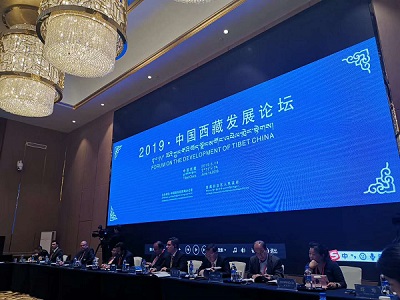Role of the Tibet Autonomous Region in the BRI
 The 2019 Forum on the Development of Tibet Autonomous Region opened on Friday in Lhasa, capital of Tibet Autonomous Region in southwest China. The one-day forum, hosted by the State Council Information Office and the people's government of Tibet Autonomous Region, gathers nearly 160 scholars and officials from 37 countries and regions. Focusing on the Belt and Road Initiative and Tibet Autonomous Region's opening-up and development, attendees will discuss topics such as the role of Tibet Autonomous Region in the building of the Belt and Road, and the opening-up of Tibet Autonomous Region and the inheritance and development of Tibetan culture.
The 2019 Forum on the Development of Tibet Autonomous Region opened on Friday in Lhasa, capital of Tibet Autonomous Region in southwest China. The one-day forum, hosted by the State Council Information Office and the people's government of Tibet Autonomous Region, gathers nearly 160 scholars and officials from 37 countries and regions. Focusing on the Belt and Road Initiative and Tibet Autonomous Region's opening-up and development, attendees will discuss topics such as the role of Tibet Autonomous Region in the building of the Belt and Road, and the opening-up of Tibet Autonomous Region and the inheritance and development of Tibetan culture.
Prior to the forum, the delegates visited villages, elementary schools and maker-spaces in Nyingchi of southeast Tibet Autonomous Region, and held talks with people from various walks of life. In the regional capital Lhasa, they visited a welfare facility, a hospital specialized in Tibetan medicine and a high school. They visited the Potala Palace, Jokhang Temple, and Barkhor Street to learn first-hand about the protection of cultural relics and traditional culture in Tibet Autonomous Region. The delegates also visited a memorial hall that marks the emancipation of serfs. This year, Tibet Autonomous Region celebrates the 60th anniversary of democratic reform that abolished serfdom.
The Belt and Road Initiative (BRI)proposed by Chinese President Xi Jinping in 2013 has deemed a boon for many developing countries for their enhanced infrastructure. Over 125 countries have signed up the BRI document so far. With the participation in the BRI, China's connectivity has further deepened with the BRI participating countries Those countries participating in the BRI have enjoyed opportunities for infrastructure development, cultural promotion and socio-economic development through mutual learning and win-win cooperation, thereby heading to prosperity from poverty alleviation. The BRI members have also got chance for global partnership and achieving economic growth. The technological advancement and reserve of capital obtained by China has not only benefited the Chinese people but also the peoples living across the globe. As the provinces of China are cooperating with other countries for reaping more benefits from BRI, the Tibet Autonomous Region.
 TAR, the gateway to South Asia for China is the highest plateau in the world, a rich cultural site and the home of honest citizen with pristine environment is luring millions of tourists. In the recent years, the Roof of the World has obtained its new identity Heavenly Path with the development of Qinghai-Tibet Autonomous Region Railway With continuous double-digit economic growth rate for past 26 years, the TAR has the highest level of economic growth rate among the Chinese states. Tourism as its key source of income. TAR welcomes 30 million tourists every year. Tibet Autonomous Region is adjoined with Xinjiang, Qinghai, Sichuan and Yunnan of China's mainland and shares its border with South Asian countries, namely Nepal, India, Pakistan, Bhutan and Myanmar. Despite Its international border with five countries Tibet Autonomous Region’s relation with Nepal is age-old and very close.
TAR, the gateway to South Asia for China is the highest plateau in the world, a rich cultural site and the home of honest citizen with pristine environment is luring millions of tourists. In the recent years, the Roof of the World has obtained its new identity Heavenly Path with the development of Qinghai-Tibet Autonomous Region Railway With continuous double-digit economic growth rate for past 26 years, the TAR has the highest level of economic growth rate among the Chinese states. Tourism as its key source of income. TAR welcomes 30 million tourists every year. Tibet Autonomous Region is adjoined with Xinjiang, Qinghai, Sichuan and Yunnan of China's mainland and shares its border with South Asian countries, namely Nepal, India, Pakistan, Bhutan and Myanmar. Despite Its international border with five countries Tibet Autonomous Region’s relation with Nepal is age-old and very close.
Tibet Autonomous Region and Nepal have the borderline of 1414 kilometers and Tibet Autonomous Region and Nepal are linked by Mt Qomolangma. Besides, Tibet Autonomous Region's huge chunk of international trade is with Nepal. Interestingly, the only Tibet Autonomous Region-based diplomatic mission is Nepal’s office of the counsel general and it has the only international air service with Nepal. The foreign trade of China taking place from Tibet Autonomous Region's border point is the highest with Nepal with record 90 percent. The Shigatse to Gyirong section is linked by Highway, named the Friendship Highway. In the recent China visit of Nepal's President, Vidhya Devi Bhandari, the two governments have signed the transit and transport protocol as agreed upon, Nepal and China would trade from six different border points i.e. Gyirong, Kimangthanka, Korala, Yari and Olangchungola Tibet Autonomous Region is expanding its relations with South Asia via Nepal through roadways and air route. A railway is likely in the future.